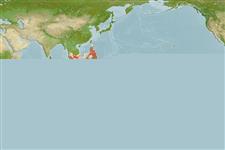>
Eupercaria/misc (Various families in series Eupercaria) >
Labridae (Wrasses) > Cheilininae
Etymology: Cirrhilabrus: Latin, cirrus = curl fringe + Greek, labros = furious (Ref. 45335); flavidorsalis: From the bright yellow outer half of the dorsal fin of the male..
More on authors: Randall & Carpenter.
Environment: milieu / climate zone / depth range / distribution range
Ecologia
marinhas associadas(os) a recifes; intervalo de profundidade 6 - 40 m (Ref. 26153), usually 6 - 28 m (Ref. 37816). Tropical
Western Central Pacific: Eastern Indonesia (northeast Kalimantan and Bali to West Papua), Malaysia (Sabah), and Philippines.
Tamanho / Peso / Idade
Maturity: Lm ? range ? - ? cm
Max length : 6.5 cm TL macho/indeterminado; (Ref. 48636)
Descrição breve
Chaves de identificação | Morfologia | Morfometria
Espinhos dorsais (total) : 11; Raios dorsais moles (total) : 9; Espinhos anais: 3; Raios anais moles: 9. Males highly variable in color with dorsal fin colors from all yellow to red or blue, and body from red to pink or white, depending on mood and stage (Ref. 48636).
Inhabits finely branching corals on protected coral and rubble slopes. Occurs in aggregations (Ref. 37816).
Life cycle and mating behavior
Maturities | Reprodução | Spawnings | Egg(s) | Fecundities | Larvas
Distinct pairing during breeding (Ref. 205).
Randall, J.E. and K.E. Carpenter, 1980. Three new labrid fishes of the genus Cirrhilabrus from the Philippines. Rev. Fr. Aquariol. 7(1):17-26. (Ref. 26153)
Categoria na Lista Vermelha da IUCN (Ref. 130435)
Ameaça para o homem
Harmless
Utilização humana
Ferramentas
Relatórios especiais
Descarregue XML
Fontes da internet
Estimates based on models
Preferred temperature (Ref.
123201): 28 - 29, mean 28.6 °C (based on 192 cells).
Phylogenetic diversity index (Ref.
82804): PD
50 = 0.5000 [Uniqueness, from 0.5 = low to 2.0 = high].
Bayesian length-weight: a=0.01585 (0.00707 - 0.03555), b=2.95 (2.76 - 3.14), in cm total length, based on LWR estimates for this (Sub)family-body shape (Ref.
93245).
Nível Trófico (Ref.
69278): 3.3 ±0.4 se; based on size and trophs of closest relatives
Resiliência (Ref.
120179): Elevada, tempo mínimo de duplicação da população menor que 15 meses (Preliminary K or Fecundity.).
Fishing Vulnerability (Ref.
59153): Low vulnerability (10 of 100).
Nutrients (Ref.
124155): Calcium = 161 [93, 356] mg/100g; Iron = 1.17 [0.64, 2.29] mg/100g; Protein = 18.2 [15.2, 20.4] %; Omega3 = 0.181 [0.096, 0.330] g/100g; Selenium = 24.2 [12.2, 50.0] μg/100g; VitaminA = 253 [76, 954] μg/100g; Zinc = 2.22 [1.40, 3.54] mg/100g (wet weight);
